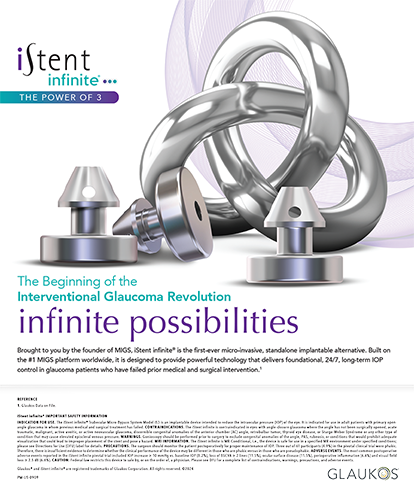Cover Stories | Jun 2005
The Tecnis Multifocal IOL
An overview of an option for presbyopic correction that is designed to reduce spherical aberration.
Manfred R. Tetz, MD
The Tecnis Multifocal lens (not currently approved by the FDA; Advanced Medical Optics, Inc., Santa Ana, CA) has enhanced ophthalmologists' IOL options. Not only does this lens perform as a foldable, diffractive, multifocal IOL with an improved near addition, its optic also incorporates “intelligent asphericity” to counteract most corneal spherical aberrations. I now have more than 1 year's clinical experience with this lens.
DESIGN
The Tecnis Multifocal IOL is based on the aspheric optic design of the Tecnis IOL (Advanced Medical Optics, Inc.), which was engineered to reduce the spherical aberration of an average cornea. Based on a principle of diffraction—as is the Acrysof Restor IOL (Alcon Laboratories, Inc., Fort Worth, TX)—the Tecnis Multifocal IOL features diffractive rings on its posterior surface. The lens provides patients with a near and a distant focus, each of which is distinct. The rings start very close to the optic's center and then continue out toward the periphery, usually with an increasing distance between the rings. As a result, the multifocal effect's dependence on the pupil is limited. Even in the presence of relatively small pupils, this IOL provides excellent near vision.
INNOVATIVE TECHNOLOGY
The best innovation of the Tecnis Multifocal IOL lies in its combination of two optical principles: multifocality and an “intelligent” prolate, anterior, optical surface. Whereas multifocal IOLs have been known for reducing patients' contrast sensitivity (a loss inherent in the optical principle of multifocality), the Tecnis IOL improves contrast by reducing higher-order aberrations compared with a normal monofocal optic. Investigators are conducting tests of this lens with simulations of driving during the day and night1 (Figure 1). One can therefore anticipate that the multifocal version of this lens will also offer benefits with regard to contrast sensitivity.
The amount of near addition that can be incorporated into either a refractive or diffractive lens appears to be limited. A refractive multifocal lens such as the Rezoom (Advanced Medical Optics, Inc.) has 3.50D at the lens level, approximately 2.80D on the corneal plane, and about 2.40D on the spectacle plane. Diffractive lenses such as the Acrysof Restor and the Tecnis Multifocal are 4.00D on the IOL plane, an amount that is equivalent to 3.00D at the spectacle plane. Both IOLs therefore provide a superior near focus to that of refractive multifocal lenses; even if the final IOL power is a little off (eg, +0.25 or even +0.50D), these diffractive multifocal IOLs still work efficiently.
The injectors for silicone IOLs from Advanced Medical Optics, Inc., work perfectly with the Tecnis line of IOLs, and the company's three versions of Healon may all be used.
CLINICAL RESULTS
A series of clinical studies2-4 has demonstrated the excellent performance of the Tecnis monofocal IOL under mesopic and scotopic lighting conditions.
My results with the Tecnis Multifocal IOL during the past year have shown the lens to be especially effective in emmetropic and hyperopic presbyopes, because their corneas seem to be closer to the average corneal asphericity incorporated into the design of the lens. These patients' reading capabilities are excellent.
As for optical aberrations, every lens with more than one focus will be associated with some degree of glare or halos, because one image is laid over another. It may be that patients who receive the Tecnis Multifocal and whose corneas fit the parameters considered typical by the designers of the aspheric Tecnis platform will be less affected by halos. Regardless, this multifocal lens should be an excellent option for patients with hyperopic or emmetropic presbyopia who are undergoing cataract surgery or refractive lens exchange.
Manfred R. Tetz, MD, is Professor of Ophthalmology and Director of his private surgical Eye-Center-Spreebogen in Berlin. He is also Scientific Director of the newly founded Berlin Eye Research Institute (BERI). He states that he holds no financial interest in any of the products or companies mentioned herein. Professor Tetz may be reached at +49 30 3980980; info@augentagesklinik-spreebogen.de or
beri@atk-spreebogen.de.
1. Javitt J. Wavefront-corrected IOL (Tecnis Z9000) is associated with improved driving safety. Paper presented at: The 18th Congress of German Ophthalmic Surgeons (DOG); June 25, 2004; Nürnberg, Germany.
2. Mester U, Dillinger P, Anterist N. Impact of a modified optic design on visual function: clinical comparative study. J Cataract Refract Surg. 2003;29:652-660.
3. Chierego C, Scialdone A, Belluci R, Buratto L. Contrast sensitivity with Tecnis and with conventional IOL. Paper presented at: The XX Congress of the ESCRS; September 10, 2002; Nice, France.
4. Packer M, Fine IH, Hoffman RS, Piers PA. Improved functional vision with a modified prolate intraocular lens. J Cataract Refract Surg. 2004;30:986-992.


